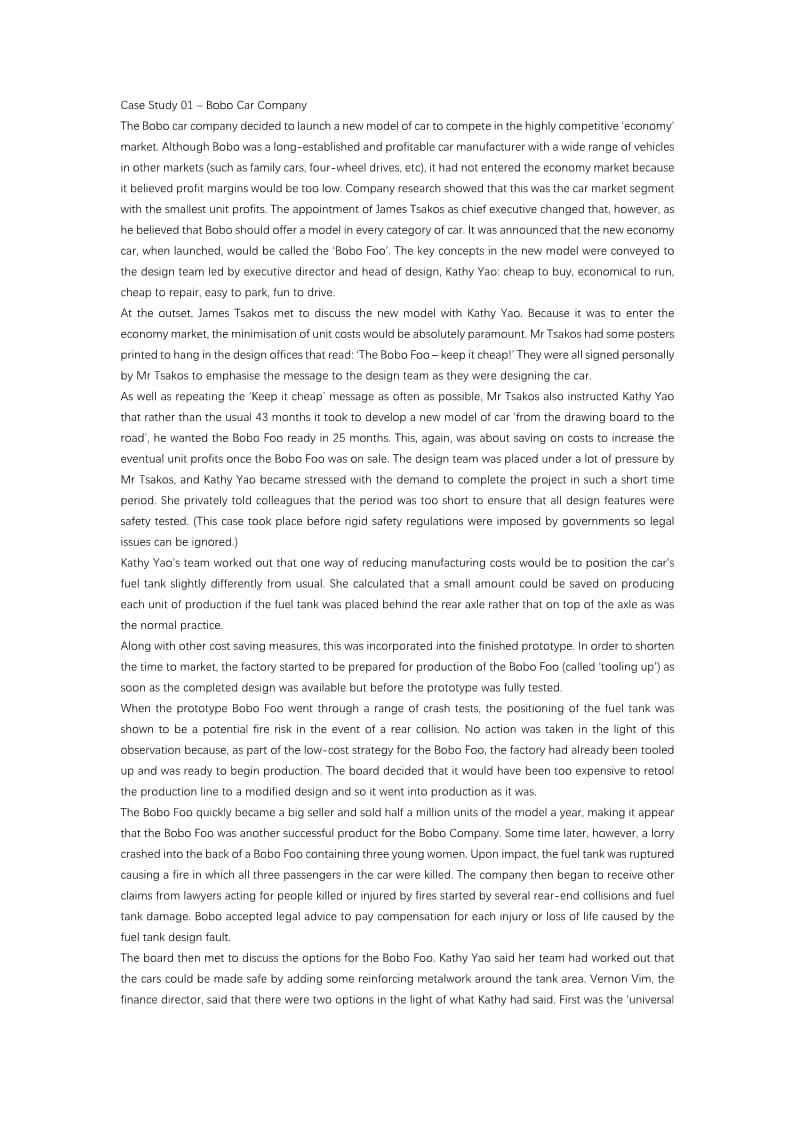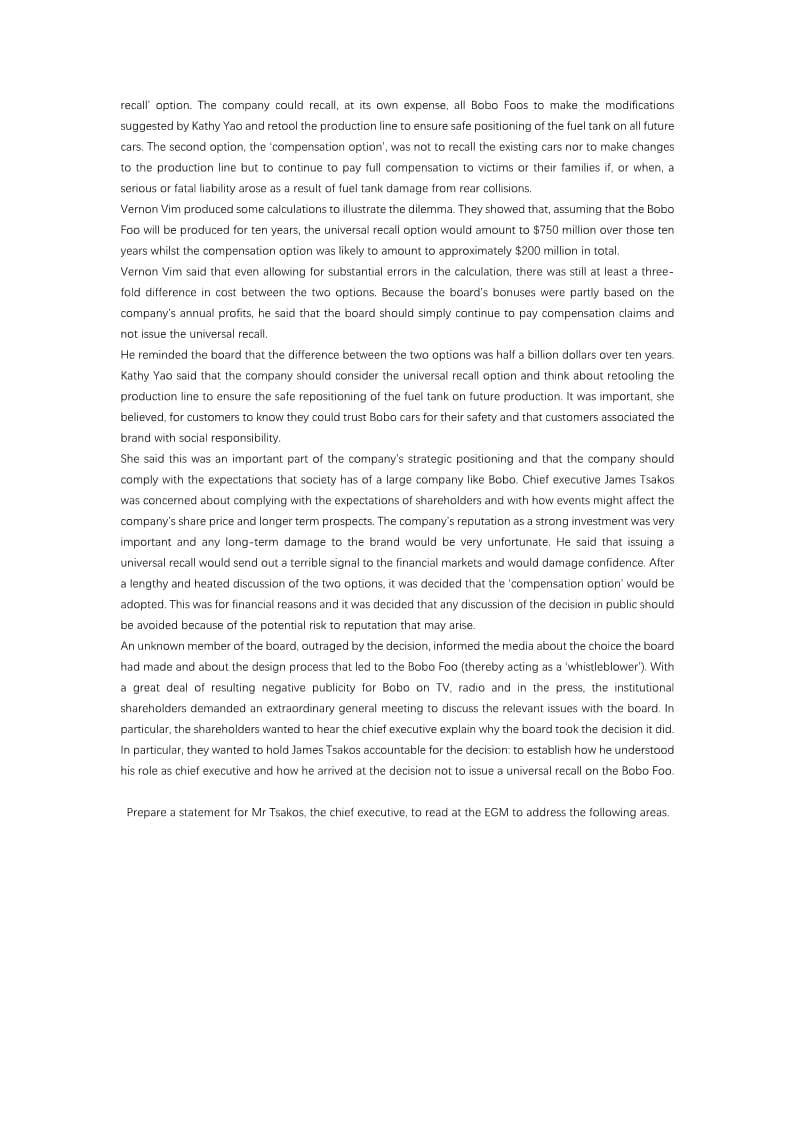Prepare a statement for Mr Tsakos, the chief executive, to read at the EGM to address the following areas. (i) An explanation of the roles of the chief executive in managing the issues described in the case at Bobo Company; (ii) A defence of the company’s decisions on the Bobo Foo from a ‘pristine capitalist’ ethical perspective (using Gray, Owen & Adams’s framework).
Prepare a statement for Mr Tsakos, the chief executive, to read at the EGM to address the following areas. (i) An explanation of the roles of the chief executive in managing the issues described in the case at Bobo Company; (ii) A defence of the company’s decisions on the Bobo Foo from a ‘pristine capitalist’ ethical perspective (using Gray, Owen & Adams’s framework).
Chapter1: Taking Risks And Making Profits Within The Dynamic Business Environment
Section: Chapter Questions
Problem 1CE
Related questions
Question
Prepare a statement for Mr Tsakos, the chief executive, to read at the EGM to address the following areas.
(i) An explanation of the roles of the chief executive in managing the issues described in the case at Bobo Company;
(ii) A defence of the company’s decisions on the Bobo Foo from a ‘pristine capitalist’ ethical perspective (using Gray, Owen & Adams’s framework).

Transcribed Image Text:Case Study 01 Bobo Car Company
The Bobo car company decided to launch a new model of car to compete in the highly competitive 'economy
market. Although Bobo was a long-established and profitable car manufacturer with a wide range of vehicles
in other markets (such as family cars, four-wheel drives, etc), it had not entered the economy market because
it believed profit margins would be too low. Company research showed that this was the car market segment
with the smallest unit profits. The appointment of James Tsakos as chief executive changed that, however, as
he believed that Bobo should offer a model in every category of car. It was announced that the new economy
car, when launched, would be called the 'Bobo Foo'. The key concepts in the new model were conveyed to
the design team led by executive director and head of design, Kathy Yao: cheap to buy, economical to run,
cheap to repair, easy to park, fun to drive.
At the outset, James Tsakos met to discuss the new model with Kathy Yao. Because it was to enter the
economy market, the minimisation of unit costs would be absolutely paramount. Mr Tsakos had some posters
printed to hang in the design offices that read: 'The Bobo Foo-keep it cheap!" They were all signed personally
by Mr Tsakos to emphasise the message to the design team as they were designing the car.
As well as repeating the 'Keep it cheap' message as often as possible, Mr Tsakos also instructed Kathy Yao
that rather than the usual 43 months it took to develop a new model of car 'from the drawing board to the
road', he wanted the Bobo Foo ready in 25 months. This, again, was about saving on costs to increase the
eventual unit profits once the Bobo Foo was on sale. The design team was placed under a lot of pressure by
Mr Tsakos, and Kathy Yao became stressed with the demand to complete the project in such a short time
period. She privately told colleagues that the period was too short to ensure that all design features were
safety tested. (This case took place before rigid safety regulations were imposed by governments so legal
issues can be ignored.)
Kathy Yao's team worked out that one way of reducing manufacturing costs would be to position the car's
fuel tank slightly differently from usual. She calculated that a small amount could be saved on producing
each unit of production if the fuel tank was placed behind the rear axle rather that on top of the axle as was
the normal practice..
Along with other cost saving measures, this was incorporated into the finished prototype. In order to shorten
the time to market, the factory started to be prepared for production of the Bobo Foo (called 'tooling up') as
soon as the completed design was available but before the prototype was fully tested.
When the prototype Bobo Foo went through a range of crash tests, the positioning of the fuel tank was
shown to be a potential fire risk in the event of a rear collision. No action was taken in the light of this
observation because, as part of the low-cost strategy for the Bobo Foo, the factory had already been tooled
up and was ready to begin production. The board decided that it would have been too expensive to retool
the production line to a modified design and so it went into production as it was.
The Bobo Foo quickly became a big seller and sold half a million units of the model a year, making it appear
that the Bobo Foo was another successful product for the Bobo Company. Some time later, however, a lorry
crashed into the back of a Bobo Foo containing three young women. Upon impact, the fuel tank was ruptured
causing a fire in which all three passengers in the car were killed. The company then began to receive other
claims from lawyers acting for people killed or injured by fires started by several rear-end collisions and fuel
tank damage. Bobo accepted legal advice to pay compensation for each injury or loss of life caused by the
fuel tank design fault.
The board then met to discuss the options for the Bobo Foo. Kathy Yao said her team had worked out that
the cars could be made safe by adding some reinforcing metalwork around the tank area. Vernon Vim, the
finance director, said that there were two options in the light of what Kathy had said. First was the 'universal

Transcribed Image Text:recall' option. The company could recall, at its own expense, all Bobo Foos to make the modifications
suggested by Kathy Yao and retool the production line to ensure safe positioning of the fuel tank on all future
cars. The second option, the 'compensation option', was not to recall the existing cars nor to make changes
to the production line but to continue to pay full compensation to victims or their families if, or when, a
serious or fatal liability arose as a result of fuel tank damage from rear collisions.
Vernon Vim produced some calculations to illustrate the dilemma. They showed that, assuming that the Bobo
Foo will be produced for ten years, the universal recall option would amount to $750 million over those ten
years whilst the compensation option was likely to amount to approximately $200 million in total.
Vernon Vim said that even allowing for substantial errors in the calculation, there was still at least a three-
fold difference in cost between the two options. Because the board's bonuses were partly based on the
company's annual profits, he said that the board should simply continue to pay compensation claims and
not issue the universal recall.
He reminded the board that the difference between the two options was half a billion dollars over ten years.
Kathy Yao said that the company should consider the universal recall option and think about retooling the
production line to ensure the safe repositioning of the fuel tank on future production. It was important, she
believed, for customers to know they could trust Bobo cars for their safety and that customers associated the
brand with social responsibility.
She said this was an important part of the company's strategic positioning and that the company should
comply with the expectations that society has of a large company like Bobo. Chief executive James Tsakos
was concerned about complying with the expectations of shareholders and with how events might affect the
company's share price and longer term prospects. The company's reputation as a strong investment was very
important and any long-term damage to the brand would be very unfortunate. He said that issuing a
universal recall would send out a terrible signal to the financial markets and would damage confidence. After
a lengthy and heated discussion of the two options, it was decided that the 'compensation option' would be
adopted. This was for financial reasons and it was decided that any discussion of the decision in public should
be avoided because of the potential risk to reputation that may arise.
An unknown member of the board, outraged by the decision, informed the media about the choice the board
had made and about the design process that led to the Bobo Foo (thereby acting as a 'whistleblower'). With
a great deal of resulting negative publicity for Bobo on TV, radio and in the press, the institutional
shareholders demanded an extraordinary general meeting to discuss the relevant issues with the board. In
particular, the shareholders wanted to hear the chief executive explain why the board took the decision it did.
In particular, they wanted to hold James Tsakos accountable for the decision: to establish how he understood
his role as chief executive and how he arrived at the decision not to issue a universal recall on the Bobo Foo.
Prepare a statement for Mr Tsakos, the chief executive, to read at the EGM to address the following areas.
Expert Solution
This question has been solved!
Explore an expertly crafted, step-by-step solution for a thorough understanding of key concepts.
Step by step
Solved in 4 steps

Recommended textbooks for you

Understanding Business
Management
ISBN:
9781259929434
Author:
William Nickels
Publisher:
McGraw-Hill Education

Management (14th Edition)
Management
ISBN:
9780134527604
Author:
Stephen P. Robbins, Mary A. Coulter
Publisher:
PEARSON

Spreadsheet Modeling & Decision Analysis: A Pract…
Management
ISBN:
9781305947412
Author:
Cliff Ragsdale
Publisher:
Cengage Learning

Understanding Business
Management
ISBN:
9781259929434
Author:
William Nickels
Publisher:
McGraw-Hill Education

Management (14th Edition)
Management
ISBN:
9780134527604
Author:
Stephen P. Robbins, Mary A. Coulter
Publisher:
PEARSON

Spreadsheet Modeling & Decision Analysis: A Pract…
Management
ISBN:
9781305947412
Author:
Cliff Ragsdale
Publisher:
Cengage Learning

Management Information Systems: Managing The Digi…
Management
ISBN:
9780135191798
Author:
Kenneth C. Laudon, Jane P. Laudon
Publisher:
PEARSON

Business Essentials (12th Edition) (What's New in…
Management
ISBN:
9780134728391
Author:
Ronald J. Ebert, Ricky W. Griffin
Publisher:
PEARSON

Fundamentals of Management (10th Edition)
Management
ISBN:
9780134237473
Author:
Stephen P. Robbins, Mary A. Coulter, David A. De Cenzo
Publisher:
PEARSON